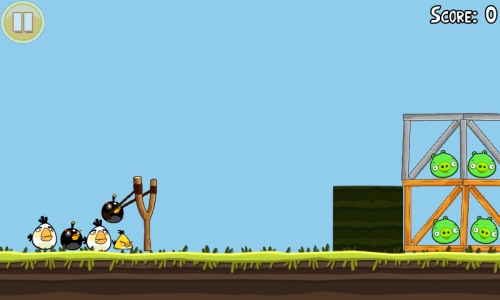For this critical play, I decided to play two Physics games: Cut the Rope and Angry Birds. I surprisingly haven’t played these games, despite their extreme popularity in the early 2010s. However, I thought my slight knowledge of physics would help me in this game (tldr…it didn’t).
Both of these seem like mindless games that people typically play to stop thinking. However, their themes play a strong role in the emotions that the game evokes, providing users with a unique experience despite the similar genre and mechanics.
Angry Birds

When playing Angry Birds, players assume the role of birds who are trying to protect their eggs in order to ensure a thriving future. They learn to distrust the enemy pigs, putting them into an offensive or aggressive mindset. A player’s sole goal is to take down the pigs by any means necessary. Part of the enjoyment is derived from the sounds that the birds make when you take out the pigs. It sounds as if they are pleased with your performance and approvingly chirping. This feedback encourages users to continue knocking out the pig. Finally, players get a kick out of hearing the popping of pigs. Few people would want to kill a real pig themselves, but there is something so satisfying about hearing them pop like bubble wrap.
Of course, the simple mechanics that can be observed in daily life also make the game fun. One needs absolutely no formal physics education in order to understand how different angles of trajectory and the force applied by the slingshot affect the distance and speed that the bird will travel at. Yet simplicity makes it perfect to escape one’s life. This form of “submission” is enhanced by the adolescent-like cartoon characters and aesthetics.
Cut the Rope

This game is similar to Angry Birds in that it is incredibly low-investment and is would be played to escape your day. However, the emotions that the game evokes are the exact opposite. Rather than feeling aggressive, one simply feels joyous. The entire premise of the game revolves around trying to feed Om Nom, an adorable green monster a piece of candy. Players can’t help but let out a smile when they see Om Nom smile after receiving his candy. On the flip side, you feel absolutely guilty if you fail to give Om Nom his candy as he puts on a big frown. Rather than feeling aggression, you’re simply trying to make a cute monster happy, which makes the game fun.
The mechanics of using ropes to swing around the candy and use bubbles to make it float brings back the nostalgia of when kids would play on the swings or play with bubbles. Many of the features are reminiscent of one’s childhood, not only making this game great for young players, but also for adults who are tired of adulting.


